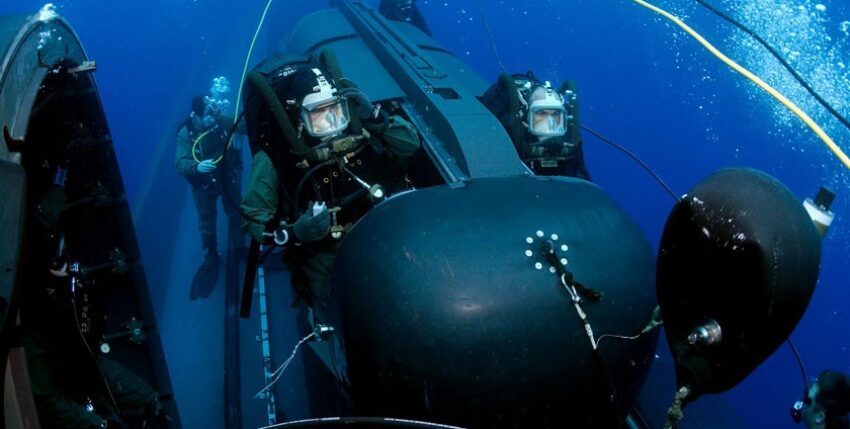The American special forces are also considered to be well equipped for use in the maritime sector. New developments are expected to significantly improve the existing capabilities.
In future, special forces must also be able to operate anywhere in the world and in any operational environment. This includes the ability to fight terrorism and insurgents. Nevertheless, the return of great power rivalry to the centre of US defence strategy means that special forces will also be increasingly geared towards operations against Russia and China. Last but not least, this means an upgrading of the polar regions.
These developments affect all US special forces. These are grouped together in the US Special Operations Command (Socom). At the same time, the special forces are also subordinate to TSK-specific high commands. The US Navy's Special Forces Command is known as Naval Special Warfare Command (NSWC); the operational forces are predominantly formed by the Seal combat swimmers (SEa-Air-Land) and the SWCC (Special Warfare Combatant Craft), supplemented by support personnel.
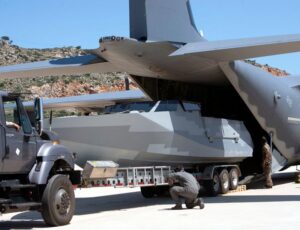
Various development and procurement programmes are currently underway to equip the Navy's special forces for the more demanding operational environment of the future. The main aim is to deploy troops faster and as unnoticed as possible, to increase situational awareness and communication and data capacity and to improve the combat effectiveness and self-protection of the special forces. The Socom unit responsible for the development and procurement of maritime systems is currently pursuing 15 individual projects. The focus of this modernisation is on new fast patrol boats and small submarines for transporting command and control forces.
Speedboats
The SWCC special forces will receive three new types of speedboats armed with machine guns for use as tactical personnel carriers and as reconnaissance and combat boats in coastal waters. The modernisation of the fast patrol boat fleet is almost complete; of 65 planned boats of all classes, more than 60 have been delivered to date.
All of these boat types will be equipped with new sensors, including an advanced Forward Looking Infra-Red (FLIR) for locating, detecting and tracking static and moving objects in the maritime environment. The CC FLIR 2 system will make it possible to engage enemy targets from a greater distance. More than 20 of the 58 planned systems of this type have been delivered to date. Initial Operational Capability (IOC) was achieved in 2018. Full operational capability (FOC) is targeted for 2024.
A new, modular communications system will also be introduced, which will be continuously equipped with the latest components in the future. This will enable the establishment of a tactical data and communications network. This Maritime Tactical Mission Networking network - also known as Mountain Man - between the boat and other maritime units will facilitate the creation of a comprehensive situational picture.
Combatant Craft - Assault
The Combatant Craft - Assault (CCA) fast attack craft is primarily used to intercept enemy or suspicious maritime targets. It can also be used to transport special forces or for coastal patrols. In addition to the boat crew, a squad of marines or seals can be taken on board. The CCA has a medium operational range and is designed for medium to high threat areas.
The manufacturer is US Marine Inc (USMI). The 12.6 metre long boat is made of radar-repellent composite material. It is only slightly larger than the eleven-metre rigid hull inflatable boats (RHIB) also used by special forces, but has an increased range, cruising and payload capacity. A small sensor mast houses a navigation radar, electro-optical and infrared cameras and a satellite communications antenna. The boat can be dropped by parachute from a transport aircraft the size of a C-17. "It's a great workhorse," explained Captain Rocky Russel, Socom programme manager for surface systems procurement. "The boat is modular and small enough to be easily deployed within the theatre of operations. It can take a special forces team to its destination and is also well suited for boarding operations. These boats are used extensively abroad." Full operational capability of all 32 units was achieved in 2017. A further tranche was commissioned in summer 2020. Socom has not announced how many additional boats will be procured by 2025. Some of the new boats will replace the oldest CCA, which are already showing signs of wear due to the high operational tempo. Socom is also currently developing a new sensor mast for the CCA.
Combatant Craft - Medium
The medium Combatant Craft - Medium (CCM) is used to transport seal commandos and other special forces and provides them with fire support. Other tasks include counter-terrorism and boarding missions as well as reconnaissance and surveillance. It is deployed in the operational environment of the medium to high threat level. The boat can be configured according to the respective mission requirements. Built by Vigor Works, the boat is 18.5 metres long and displaces 29.8 tonnes. With a draught of just over one metre, it can enter the shallowest waters. The maximum speed is 52 knots; at a speed of 40 knots, the range is 600 nautical miles. In addition to the crew of four, a further 19 people and their combat equipment can be transported. The last of 30 planned units was delivered in 2020.
The introduction of CC FLIR 2 will enable the CCM to be equipped with precision missiles for engaging sea and coastal targets in the future. There are also plans to install a submersible machine gun on the bow.
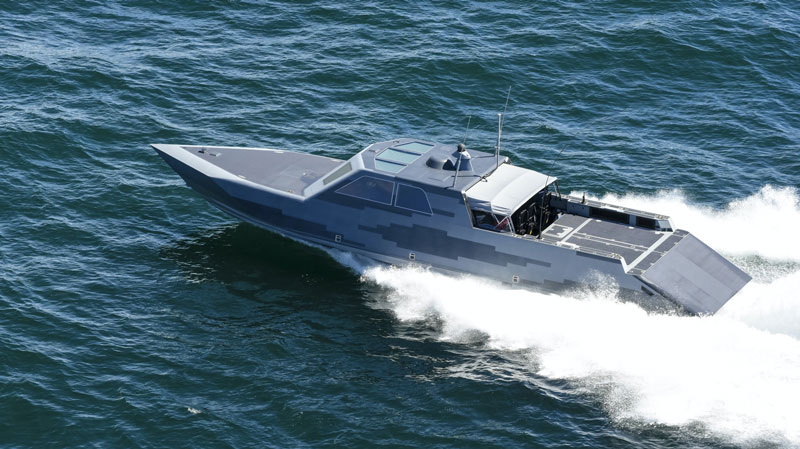
Combatant Craft - Heavy (Sealion)
The heavy Combatant Craft - Heavy (CCH) is used for the surface transport of commandos. Other tasks include reconnaissance and surveillance in coastal areas, boarding missions and engaging enemy speedboats or coastal targets. The boat type was introduced six years ago. The last of three planned units will enter service in 2021. The additional designation Sealion stands for Sea, Air, Land Insertion, Observation and Neutralisation. As this name suggests, the fast patrol boat can be transported to the area of operation on the flood deck of an amphibious ship, by wide-bodied aircraft or by lorry.
The boats produced by Vigor Works are seaworthy and can be launched either from the harbour or from the flood deck of an amphibious ship. The 25 metre long boats have a displacement of 36 tonnes. The forward cockpit has seven seats for the crew and standing room for up to twelve commandos. The flattened underside of the hull means that the boat partially sails on the surface of the water at high speed. The range and maximum performance are confidential; some sources estimate the maximum speed at up to 60 knots. At low speed, the boat is so low in the water that it is sometimes categorised as a semi-submersible. The extremely low silhouette, coupled with a low radar signature, provides a stealth capability that is particularly valuable for reconnaissance missions.
Two retractable sensor masts are equipped with radar, FLIR, various cameras and a laser range finder and rangefinder. The payload compartment for the seals' equipment is located aft. The payload capacity is sufficient for either two Yamaha jet skis modified for special forces operations, an inflatable boat or diving equipment. Egress and recovery are via the tailgate.
Although the operational experience to date has been positive, the need for additional parameters has been identified, explained Captain Dolloff. In addition to more payload capacity, a longer range and a more powerful propulsion system, Socom is primarily aiming for much more powerful electronic equipment. This includes new computer, command and communication systems, reconnaissance and surveillance sensors and a passive electronic and cyber warfare system. In February 2019, Socom invited the relevant industry to submit proposals for a new or modified boat. In addition to its existing tasks, the Mk 2 variant should also be capable of launching, guiding and recovering unmanned surface and underwater vehicles up to eight metres long. In this context, the payload capacity was to be increased to eleven tonnes. According to the Socom request, the total length of a CCH Mk 2 should be up to 61 metres. Development of the new variant was originally scheduled to begin in 2020, but this has been postponed indefinitely for the time being.
Electric drive
One potential innovation for the SWCC combat boats would be electric propulsion. Covert operations are always the focus of the special forces. Due to their design, the very powerful propulsion systems of the SWCC speedboats also generate a high noise level; this makes it difficult to maintain the advantage of surprise during operations near the coast or on inland waters. This could be remedied by the future use of a fully electric drive or a hybrid drive. In addition to the low noise level, this solution would also have the advantage of a lower heat signature.
Mini submarines
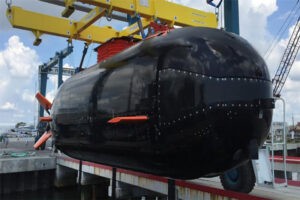
Seal combat swimmers are often brought to the vicinity of the deployment zone by ship or submarine; they cover the final distance to the deployment target in a mini-submarine. Previous boats of this type are generally open. Water currents, pressure and extreme temperatures can already contribute to diver fatigue during this approach phase. In future, seal commandos will also have a closed transport option.
The small submarine, known as the Dry Combat Submersible (DCS), is currently undergoing sea trials. The first unit is expected to be declared operationally ready (IOC) and operationally available from mid-2021; full operational capability is targeted for 2022.
DCS is being built by Lockheed Martin in co-operation with the British company MSubs, with the pressure hull being manufactured in Germany. The submarine is based on the S 351 Nemesis mini-submarine of the British special forces. Both variants are twelve metres long and 2.4 metres wide and high. They hold a two-man boat crew and eight combat divers. The interior of the boat is divided into three areas. The cockpit is located at the stern and the passenger compartment amidships. Both areas are "dry" and are under normal pressure. There is a flood chamber at the bow for the combat swimmers to get on and off.
According to a Socom representative, DCS will have a minimal noise and heat signature. The navigation and sensor equipment far exceeds that of current mini-submarines and includes two retractable sensor masts with cameras, electronic sensors and communications equipment, in addition to inertial and Doppler navigation systems, echo sounder, terrain-following sonar, underwater telephone and UHF radio, as well as the ability to locate enemy coastal and ship radar systems and classify them according to their radiation frequency. The latter capability is intended to enable the DCS to evade radar detection even in the immediate vicinity of the coast. Additional sensors and electronic components can be added on a modular basis according to the operational requirements.
Exact performance parameters are confidential. Minimum performance levels are known, including 100 metres diving depth, more than 60 nautical miles range, five knots speed and 24 hours endurance. The range corresponds to twice or three times the performance of previous seal transport vehicles.
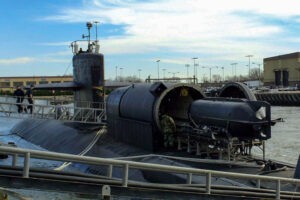
USS Dallas. Photo: US Navy
Socom admits that the range of 60 nautical miles could be problematic, especially as the DCS can initially only be launched by surface ships - by crane or via a flood deck. The submarine's mother ship would have to be within range of enemy sensors and coastal batteries in order to launch the submarine. If, as is being considered, aluminium saltwater batteries are used instead of the currently used lithium-ion batteries, the performance data should be increased at least tenfold. This would allow the vehicle to be launched several hundred nautical miles from the enemy coast, which would significantly reduce the risk of capture.
The DCS prototype currently being trialled belongs to the Block 1 variant, of which only three have been produced to date. A more powerful Block 2 variant is being planned, but the technological details have not yet been finalised. On the one hand, a version that is launched from a submarine instead of a surface vessel could be envisaged. On the other hand, even larger variants of the DCS, with greater payload capacity and range, could enter service in the future, explained James Smith, Socom's procurement director.
SWCS
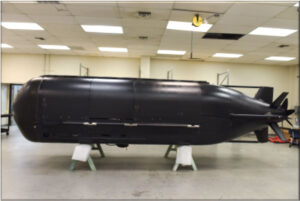
However, not every mission requires the performance of a DCS boat. Seal commands will continue to use open mini-submarines. Development of the new generation, known as the Seal Delivery Vehicle Mk 11 (SDV Mk 11) or alternatively as the Shallow Water Combat Submersible (SWCS), was initiated in 2011. Pre-series production of five units began in 2016 and five units have been delivered to date. The general contractor Teledyne Brown was awarded the contract to build five more units at the end of 2019, with deliveries planned for this year and next year. The overall procurement target is ten SDV Mk 11s to replace the older SDV Mk 8s at a ratio of 1:1.
The new underwater vehicles, which are around seven metres long, are 30 centimetres longer and 15 centimetres higher and wider than the previous Mk 8 variant; the displacement has been increased by 1.8 tonnes. SWCSs have a greater range and payload capacity than SDVs and are better equipped. Bow thrusters improve manoeuvrability. New navigation equipment, sensors and guidance systems make it possible to operate safely and unnoticed in shallow, hostile coastal waters. The modular design of the vehicles facilitates the ongoing integration of new technology to ensure that performance is constantly improved over the years of operation.
DDS
Like their predecessors, the new mini-submarines are carried in the specialised Dry Deck Shelter (DDS) hangar on the upper deck of fighter submarines. DDSs can also be used to transport underwater drones. The Navy currently has six DDSs. There is currently no prospect of procuring a new type, but the existing units are being overhauled and modernised to ensure operational capability by 2051. The work to be completed by 2023 includes lengthening the hull by 120 centimetres, increasing the payload volume by 30 per cent and introducing a main hatch that can be operated remotely from inside the carrier submarine. The conversion of the DDS will also make it possible to carry a DCS-type small submarine, which is too large for the current DDS configuration.
Operation on the opponent's doorstep
The special forces of the US Navy trace their roots back to the combat divers and speedboat units of the Second World War. The current division into Navy Seals and SWCC units was introduced during the Vietnam War. The special forces' best-known missions were in counter-guerrilla and counter-terrorism operations, whether in South East Asia, South America or the Middle East.
Nevertheless, during the Cold War, Seals and SWCC crews were also prepared for missions during a third world war. Among other things, the combat divers were to infiltrate enemy naval bases and coastal areas in order to carry out acts of sabotage, disable radar and missile systems or conduct reconnaissance. Combat divers were also trained to tap underwater Soviet telecommunications lines within enemy territorial waters.
The operational targets envisaged today in the event of a new great power conflict naturally remain confidential, but there is little doubt about potential areas of operation. Enemy interests and forces would be targeted anywhere in the world, but the war would also be fought on the enemy's doorstep - whether in the South China Sea, the Arctic, the Baltic or the Black Sea. The new deployment systems - and those that will be added in the coming years - should enable the success of such missions.
Author: Sidney E. Dean

